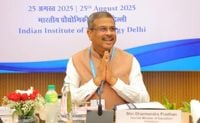With the Bihar Assembly elections looming in November 2025, the political atmosphere across the state is reaching a fever pitch. Major parties are unveiling their manifestos, alliances are being tested, and new players are vying for influence in a contest that promises to shape the future of one of India’s most politically significant states.
At the heart of this year’s electoral battle is the issue of social justice and representation for Bihar’s backward and marginalized communities. On September 24, 2025, the Congress Party, in alliance with the Rashtriya Janata Dal (RJD) under the INDIA bloc, announced a sweeping 10-point programme focused on the Extremely Backward Classes (EBC). According to Business Today, this plan is designed to grant quotas in education, employment, and land allocation for EBC, Scheduled Castes (SC), Scheduled Tribes (ST), and other Backward Classes (BC). The Congress has promised rapid implementation if their alliance comes to power, continuing Rahul Gandhi’s campaign focus on social justice.
Speaking at the resolution’s release in Patna, Rahul Gandhi declared, “During the 15-day Voter Adhikar Yatra, we went to different districts of Bihar and told the youth that the Constitution is being attacked. Not just in Bihar, but in the entire nation, citizens' rights are being snatched away.” He further asserted, “In Parliament, I said two things in front of PM Modi. First, there will be a caste-based census in the entire nation; second, we will bring down the 50% reservation wall.”
This bold promise to surpass the 50% reservation cap—long a contentious ceiling in India’s affirmative action framework—has stirred both hope and debate. The plan includes providing land to landless individuals from EBC, SC, ST, and BC categories: three decimals in urban areas and five decimals in rural areas. Additionally, Congress pledged to introduce an “Extremely Backward Classes Atrocities Prevention Act,” modeled after protections for SCs and STs, and to extend reservation benefits to all private educational institutions under Article 15(5) of the Constitution.
Congress’s agenda also calls for increasing EBC reservation in panchayats and urban local bodies from 20% to 30%, and proposes passing a law to include these expanded quotas in the Ninth Schedule of the Constitution—a move intended to shield the measures from judicial review. There’s a promise of 50% reservation for EBCs, SCs, STs, and BCs in government contracts up to ₹25 crore, overseen by a new Reservation Regulatory Authority. To address concerns over unfilled reserved posts, the party has vowed to make the “Not Found Suitable” concept illegal, ensuring vacancies are filled rather than left unoccupied due to subjective assessments. Disputes related to the EBC list will be handled by a dedicated committee.
This comprehensive push is not just about policy but also about political arithmetic. The Congress-RJD alliance is seeking to unseat the current JDU-BJP government led by Nitish Kumar, leveraging its historical association with backward class interests. As reported by India TV, the alliance’s agenda is squarely aimed at EBC, SC, ST, and backward class voters, whose support could prove decisive in the 243-seat assembly contest.
The Congress’s promises are echoed by its allies. On September 25, Priyanka Gandhi Vadra stated that the INDIA bloc had released a separate 10-point resolution for the Extremely Backward Class, which includes a new law against atrocities, increased reservations in local bodies, and specific benefits in housing, education, and government contracts. At the ‘Ati Pichhda Nyay Sankalp’ event in Patna, Rahul Gandhi assured that all these commitments would be implemented if the alliance forms the government in Bihar.
Meanwhile, the Election Commission of India (ECI) is moving swiftly to ensure a level playing field. On September 25, it instructed Bihar’s Chief Secretary and senior officials to complete all transfer and posting processes of government officers by October 6. This is standard protocol to prevent undue influence as the state gears up for polls. Once this exercise is completed, the Chief Election Commissioner is expected to visit Bihar, paving the way for the formal announcement of the election schedule. According to India TV, the Model Code of Conduct will come into immediate effect once the poll dates are declared, placing tight restrictions on government actions and announcements.
The Bharatiya Janata Party (BJP) is not sitting idle. On September 25, Union Education Minister Dharmendra Pradhan was appointed as the BJP’s in-charge for the Bihar elections, as reported by NDTV. He will be assisted by Union Jal Shakti Minister CR Patil and Uttar Pradesh minister Keshav Prasad Maurya. The BJP is positioning the election as a test of Chief Minister Nitish Kumar’s governance record against Tejashwi Yadav’s social justice push, with both sides rallying their respective bases. The BJP’s campaign will also have to contend with the influence of election strategist Prashant Kishor’s new Jan Suraaj party, which could sway crucial votes in a tight race.
Adding yet another layer to the contest is the All India Majlis-e-Ettehadul Muslimeen (AIMIM), led by Asaduddin Owaisi. On September 24, Owaisi made it clear that his party would join the INDIA bloc if it was allotted six seats in the upcoming elections. He wrote to Leader of Opposition Tejashwi Yadav, emphasizing the need to prevent a division of secular votes. Owaisi launched a four-day ‘Seemanchal Nayay Yatra’ in the northeastern border areas of Bihar—Kishanganj, Purnea, Araria, and Katihar—districts with significant Muslim populations and 24 assembly constituencies. “For several decades, the fate of the people of Seemanchal area has been decided by someone sitting in Patna but this will not happen now. People of Seemanchal will decide their fate for themselves,” Owaisi told a cheering crowd, as covered by The Hindu.
AIMIM aims to expand its presence beyond the five seats it won in 2020, despite setbacks in 2022 when four of its MLAs switched allegiance to the RJD. Owaisi has also been vocal about regional backwardness and developmental issues, seeking to carve out a distinct political space for his party in Bihar’s complex landscape.
With all 243 assembly seats up for grabs, the stakes could hardly be higher. The contest is not merely about numbers, but about narratives—development versus social justice, stability versus change, and the enduring question of how best to empower Bihar’s most marginalized citizens. As the formal election schedule awaits announcement in early October, voters are being courted with promises of transformative change and fierce debate over the best path forward.
Bihar’s 2025 elections are shaping up to be a defining moment, not just for the state, but for the broader trajectory of Indian politics. With alliances in flux and new voices demanding a seat at the table, the outcome will be watched closely from Patna to Delhi—and far beyond.






